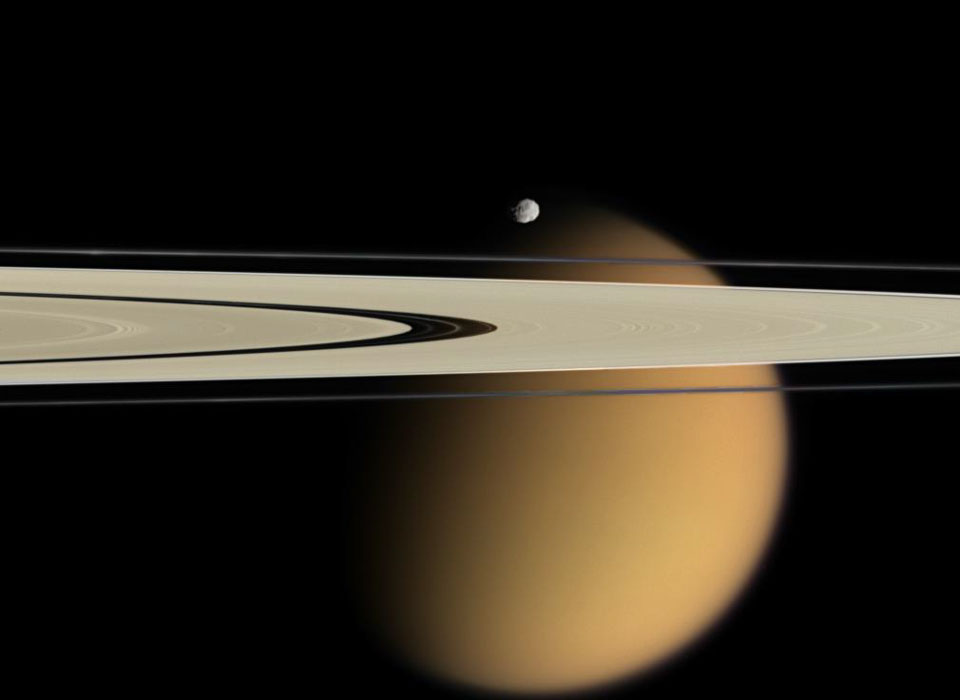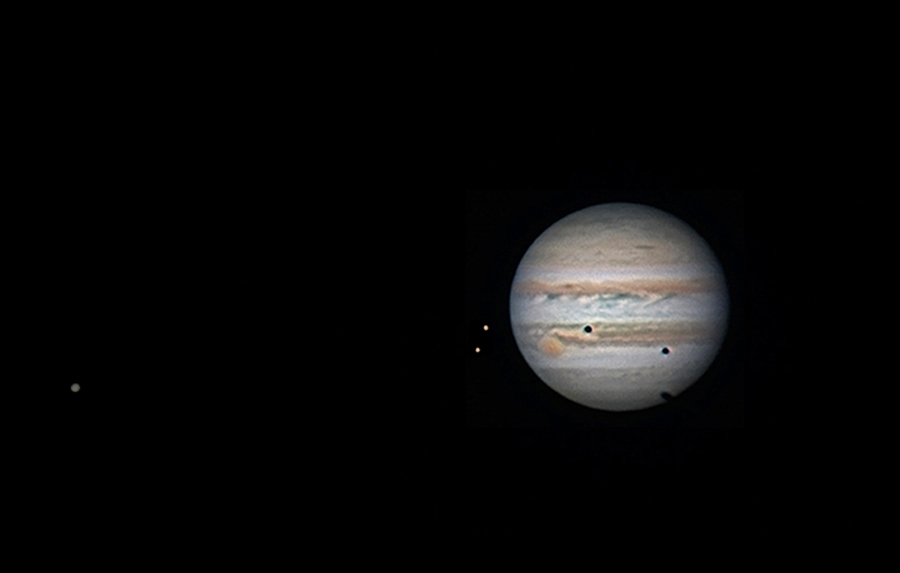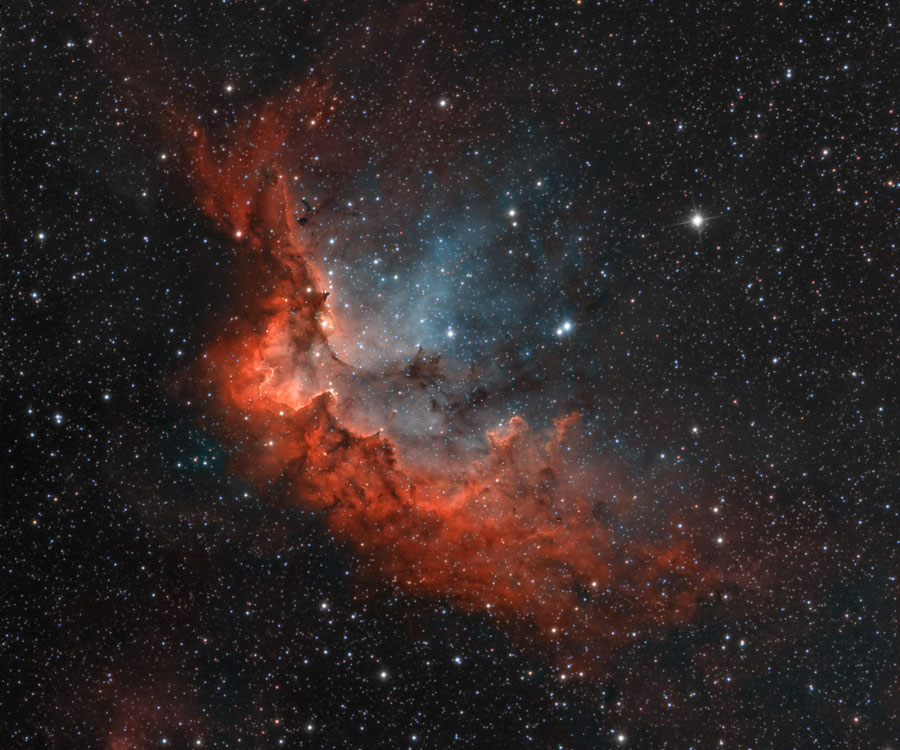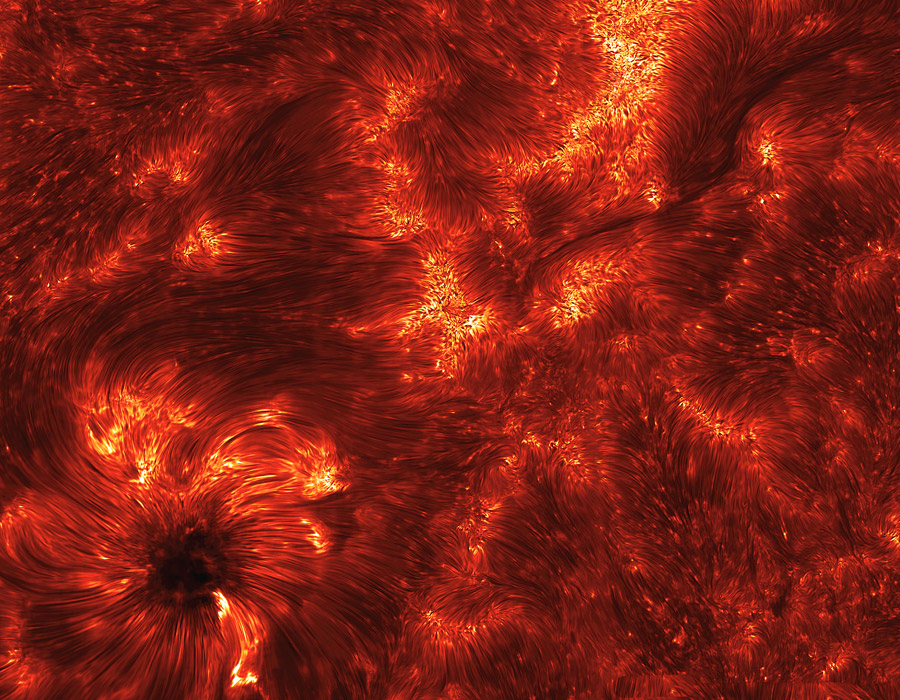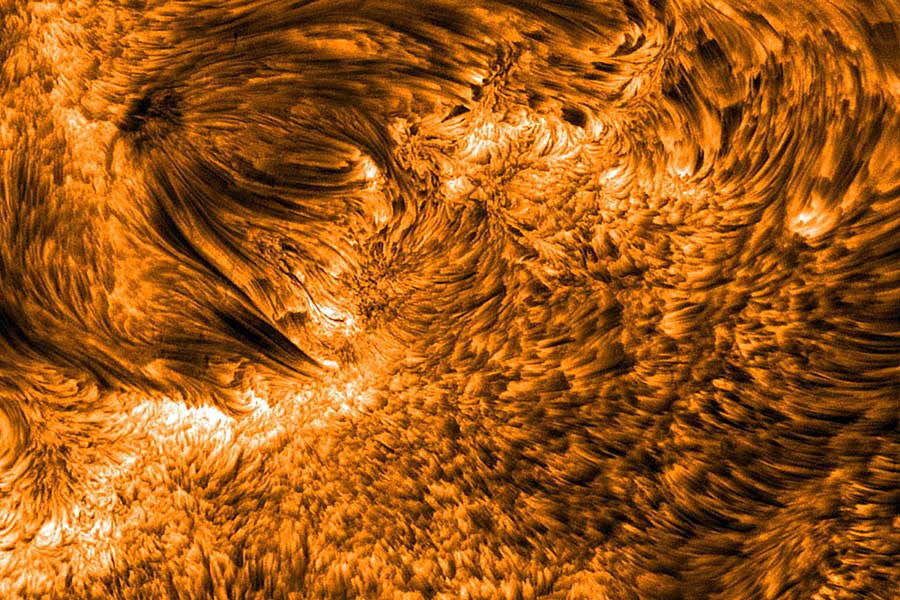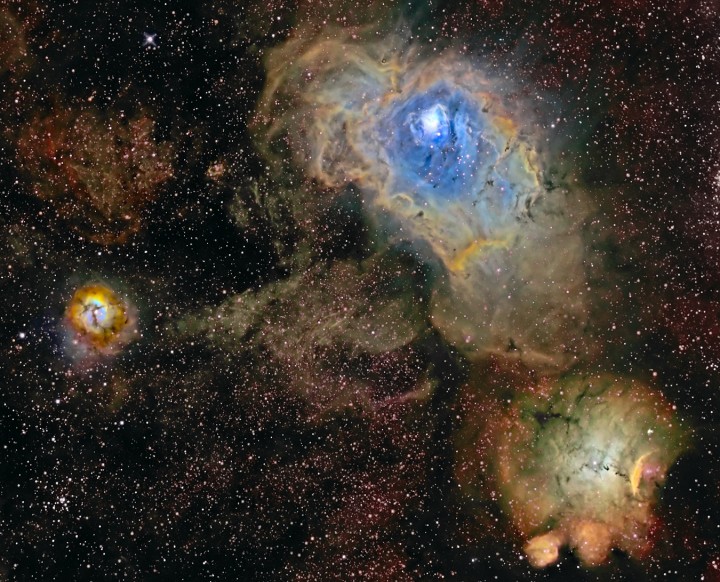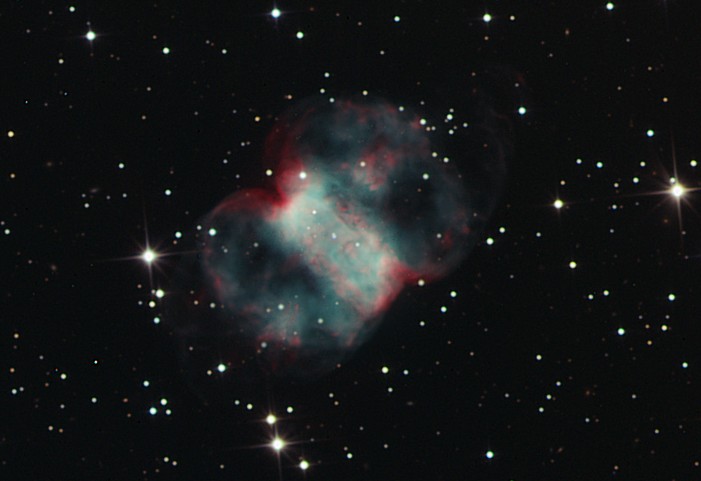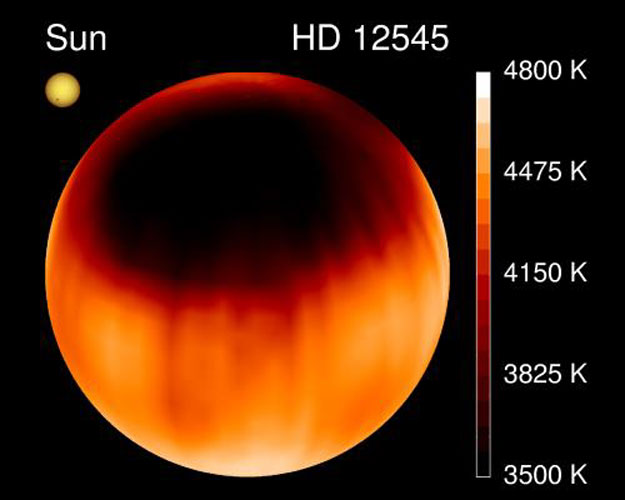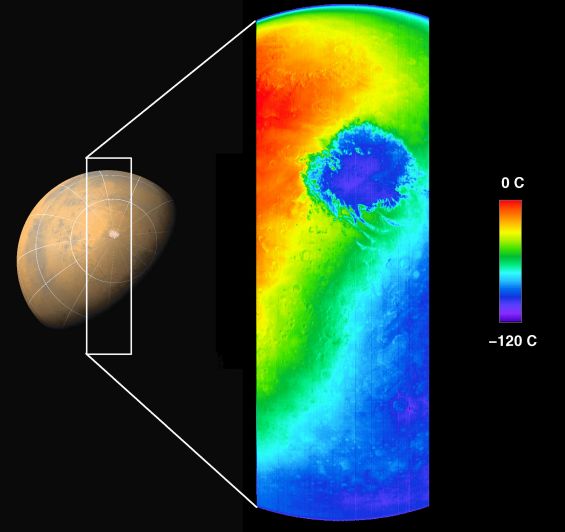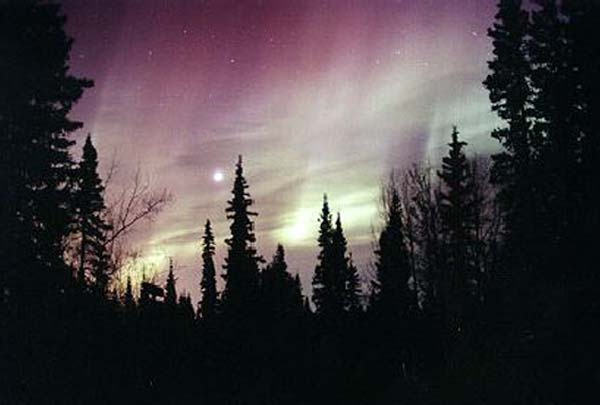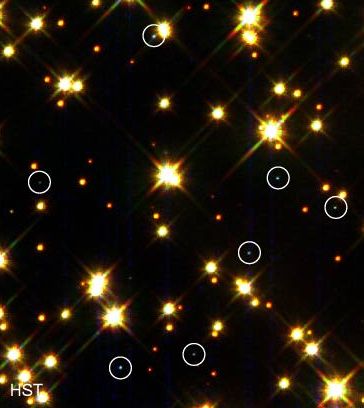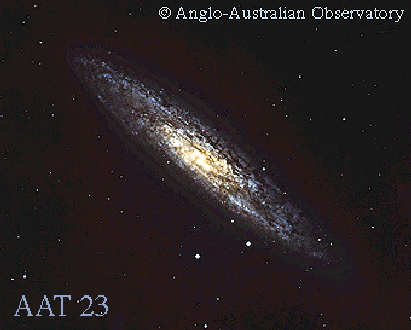| << Previous | Index | Next >> |
2014 When orbiting Saturn, be sure to watch for breathtaking superpositions of moons and rings. One such picturesque vista was visible recently to the robot Cassini spacecraft now orbiting Saturn. In 2006 April, Cassini captured Saturn's A and F rings stretching in front of cloud-shrouded Titan. Near the rings and appearing just above Titan was Epimetheus, a moon which orbits just outside the F ring. The dark space in the A ring is called the Encke Gap, although several thin knotted ringlets and even the small moon Pan orbit there.
2013 This webcam and telescope image of banded gas giant Jupiter shows the transit of three shadows cast by Jupiter's moons in progress, captured in Belgian skies on October 12 at 0528 UT. Such a three shadow transit is a relatively rare event, even for a large planet with many moons. Visible in the frame are the three Galilean moons responsible, Callisto at the far left edge, Io closest to Jupiter's disk, and Europa below and just left of Io. Of their shadows on the sunlit Jovian cloud tops, Callisto casts the most elongated one near the planet's south polar region at the bottom. Io's shadow is above and right of Jupiter's Great Red Spot. Of course viewed from Jupiter's perspective, these shadow crossings could be seen as solar eclipses, analogous to the Moon's shadow crossing the sunlit face of planet Earth.
2012 At the center of our Milky Way Galaxy, a mere 27,000 light-years away, lies a black hole with 4 million times the mass of the Sun. Fondly known as Sagittarius A* (pronounced A-star), the Milky Way's black hole is fortunately mild-mannered compared to the central black holes in distant active galaxies, much more calmly consuming material around it. From time to time it does flare-up, though. An outburst lasting several hours is captured in this series of premier X-ray images from the orbiting Nuclear Spectroscopic Telescope Array (NuSTAR). Launched last June 13, NuSTAR is the first to provide focused views of the area surrounding Sgr A* at X-ray energies higher than those accessible to Chandra and XMM observatories. Spanning two days of NuSTAR observations, the flare sequence is illustrated in the panels at the far right. X-rays are generated in material heated to over 100 million degrees Celsius, accelerated to nearly the speed of light as it falls into the Miky Way's central black hole. The main inset X-ray image spans about 100 light-years. In it, the bright white region represents the hottest material closest to the black hole, while the pinkish cloud likely belongs to a nearby supernova remnant.
2011 What powers are being wielded in the Wizard Nebula? Gravitation strong enough to form stars, and stellar winds and radiations powerful enough to create and dissolve towers of gas. Located only 8,000 light years away, the Wizard nebula, pictured above, surrounds developing open star cluster NGC 7380. Visually, the interplay of stars, gas, and dust has created a shape that appears to some like a fictional medieval sorcerer. The active star forming region spans 100 about light years, making it appear larger than the angular extent of the Moon. The Wizard Nebula can be located with a small telescope toward the constellation of the King of Aethiopia (Cepheus). Although the nebula may last only a few million years, some of the stars being formed may outlive our Sun.
2010 Imagine a pipe as wide as a state and as long as the Earth. Now imagine that this pipe is filled with hot gas moving 50,000 kilometers per hour. Further imagine that this pipe is not made of metal but a transparent magnetic field. You are envisioning just one of thousands of young spicules on the active Sun. Pictured above is one of the highest resolution image yet of these enigmatic solar flux tubes. Spicules line the above frame of solar active region 11092 that crossed the Sun last month, but are particularly evident converging on the sunspot on the lower left. Time-sequenced images have recently shown that spicules last about five minutes, starting out as tall tubes of rapidly rising gas but eventually fading as the gas peaks and falls back down to the Sun. What determines the creation and dynamics of spicules remains a topic of active research.
2009 Last week, NASA test fired a new rocket. The Ares 1-X was the first non-shuttle rocket launched from Kennedy Space Center since the Saturn launched humans to Earth orbit and the Moon in the 1960s and 1970s. NASA is testing Ares as a prelude to replacing the aging space shuttle fleet. The tremendous thrust of the Ares 1-X can bring the massive rocket from a standing start to a vertical speed of over 100 kilometers per hour in under eight seconds. The test rocket launched last week was longer than a football field and covered with over 700 sensors to record data that will enable engineers to refine details of future Ares rockets. Pictured above, the Ares 1-X blasts into space while the top part of the rocket becomes engulfed in a shock collar of water droplets likely created by the sudden drop of air pressure.
2008 Imagine a pipe as wide as a state and as long as half the Earth. Now imagine that this pipe is filled with hot gas moving 50,000 kilometers per hour. Further imagine that this pipe is not made of metal but a transparent magnetic field. You are envisioning just one of thousands of young spicules on the active Sun. Pictured above is perhaps the highest resolution image yet of these enigmatic solar flux tubes. Spicules dot the above frame of solar active region 10380 that crossed the Sun in 2004 June, but are particularly evident as a carpet of dark tubes on the right. Time-sequenced images have recently shown that spicules last about five minutes, starting out as tall tubes of rapidly rising gas but eventually fading as the gas peaks and falls back down to the Sun. These images also indicate that the ultimate cause of spicules is sound-like waves that flow over the Sun's surface but leak into the Sun's atmosphere.
2007 Narrow band filters and a false-color palette give these three nebulae a stunning appearance against the cosmic canvas of the central Milky Way. All three are stellar nurseries about 5,000 light-years or so distant, toward the nebula rich constellation Sagittarius. In the 18th century, astronomer Charles Messier cataloged two of them; colorful M8, above and right of center, and compact M20 at the left. The third, NGC 6559, is at bottom right. Over a hundred light-years across, M8 is also known as the Lagoon Nebula. Divided by obscuring dust lanes, M20's popular moniker is the Trifid. In the composite image, narrow emission lines from sulfur, hydrogen, and oxygen atoms recorded through the filters, are mapped into broader red, green, and blue colors respectively. The color scheme was made popular in Hubble Space Telescope images. But for ground-based telescopes, narrow band filters also make it possible to reject overwhelming light-pollution and capture compelling images of the cosmos from urban skies.
2006 "Nebula at the right foot of Andromeda ... " begins the description for the 76th object in Charles Messier's 18th century Catalog of Nebulae and Star Clusters. In fact, M76 is one of the fainter objects on the Messier list and is also known by the popular name of the "Little Dumbbell Nebula". Like its brighter namesake M27 (the Dumbbell Nebula), M76 is recognized as a planetary nebula - a gaseous shroud cast off by a dying sunlike star. The nebula itself is thought to be shaped more like a donut, while its box-like appearance is due to our nearly edge-on view. Gas expanding more rapidly away from the donut hole produces the faint loops of far flung material. The nebula's dying star can be picked out in this sharp color image as the bottom, blue-tinted member of the double star near the center of the box-like shape. Distance estimates place M76 about 3 to 5 thousand light-years away, making the nebula over a light-year in diameter.
2005 These two moons change places. Epimetheus and Janus, two small moons of Saturn, actually switch positions as they orbit their home planet. The orbital radii of the moons are strangely separated by less than the radii of the moons themselves: about 50 kilometers. One moon orbits Saturn well ahead of the other, at first. As the two moons gravitationally attract, they approach each other and, every few years, actually pass and trade orbits. This strange dance creates speculation that Epimetheus and Janus were once joined and later split from each other. Pictured above, the two moons were photographed rounding their orbits just outside of Saturn's F ring. The above image was taken in early September by the robot Cassini spacecraft, also orbiting Saturn.
2004 What causes storms on Saturn? To help find out, scientists commanded the robot Cassini spacecraft now orbiting Saturn to inspect a circulating band of clouds nicknamed "Storm Alley." This westwardly moving cloud ring has been unusually active since the beginning of 2004, spawning white swirling storms and dark storms ringed by sprawling white clouds all cascading around the gas giant. The rogue band, as well as other parts of south Saturn, were imaged in stunning detail in a very specific band of infrared light that passes through Saturn's upper haze relatively unblurred. The result was then digitally sharpened, showing more cloud detail but creating fake image artifacts such as a surrounding ring. Speculation on the nature of past Saturn storms included convective motions of small amounts of ammonia and water, seasons, and shadowing effects of the great ring system. Although the above image provides data and clues, the power behind Saturn's storms still remains a mystery.
2003 What could cause a star to have such a large spot? Our Sun itself frequently has sunspots, relatively cool dark magnetic depressions that move across its surface. HD 12545, however, exhibits the largest starspots yet observed. Doppler imaging - the use of slight changes in color caused by the rotation of the star - was used to create this false-color image. The vertical bar on the right gives a temperature scale in kelvins. This giant, binary, RS CVn star, also known as XX Trianguli, is visible with binoculars in the constellation of Triangulum. The starspot is thought to be caused by large magnetic fields that inhibit hot matter from flowing to the surface.
2002 Scattered within this cavernous nebula, cataloged as NGC 604, are over 200 newly formed hot, massive, stars. At 1,500 light-years across, this expansive cloud of interstellar gas and dust is effectively a giant stellar nursery located some three million light-years distant in the spiral galaxy, M33. The newborn stars irradiate the gas with energetic ultraviolet light stripping electrons from atoms and producing a characteristic nebular glow. The details of the nebula's structure hold clues to the mysteries of star formation and galaxy evolution.
2001 Not an ancient Greek goddess, THEMIS is modern acronese for THermal EMission Imaging System. Above is this remarkable instrument's premier infrared image of Mars, from the newly orbiting Mars Odyssey spacecraft. Taken on October 30th, the sharp infrared picture covers the indicated swath of the martian southern hemisphere and shows surface temperatures in false-colors ranging from red, a warm 0 degrees Celsius, to cool purple shades of -120 degrees C. The striking, cold circular feature is Mars' south polar ice cap. Composed of frozen carbon dioxide, the ice cap is about 900 kilometers wide and shrinking during the onslaught of southern hemisphere summer. Temperatures are also seen to drop as the bottom portion of the THEMIS image sweeps beyond the terminator or shadow line, into the martian night. A thin, light blue crescent along the upper edge of the planet is the martian atmosphere. The THEMIS image data was recorded as a test of the camera system from an altitude of about 22,000 kilometers.
2000 Galaxies don't normally look like this. NGC 6745 actually shows the results of two galaxies that have been colliding for only hundreds of millions of years. Just off the above photograph to the lower right is the smaller galaxy, moving away. The larger galaxy, pictured above, used to be a spiral galaxy but now is damaged and appears peculiar. Gravity has distorted the shapes of the galaxies. Although it is likely that no stars in the two galaxies directly collided, the gas, dust, and ambient magnetic fields do interact directly. In fact, a knot of gas pulled off the larger galaxy on the lower right has now begun to form stars. NGC 6745 spans about 80 thousand light-years across and is located about 200 million light-years away.
1999 A night sky can glow in fascinating ways. Through a clearing in the woods, the pictured sky above Alaska shines by reflected light from a nearby city, by the brightness of the Moon, and by aurora. The night sky in or near a city appears to contain relatively few stars because lights there reflect off atmospheric particles, hiding stars in a diffuse glow. The bright Moon also creates a diffuse sky glow, although much less bright than the analogous blue-sky glow created during the day by the Sun. Particles from the Sun crashing into the Earth's atmosphere are seen here as bands of aurora. These glows also illuminate visible clouds. Auroral displays are becoming more frequent as the Sun approaches Solar Maximum.
1998 In this tangle of quasars and galaxies lies a clue to the expansion rate of the universe. A diffuse glow evident in the picture on the left reveals a normal elliptical galaxy. Directly behind this galaxy lies a normal quasar. Because the quasar is directly behind the galaxy, however, the gravity of the galaxy deflects quasar light like a lens, creating four bright images of the same distant quasar. When these images are all digitally subtracted, a distorted image of the background galaxy that hosts the quasar appears - here shown on the right in ghostly white. Each quasar image traces how the quasar looked at different times in the past, with the time between images influenced by the expansion rate of the universe itself. Assuming dark matter in the elliptical lens galaxy traces the visible matter, this expansion rate can be characterized by a Hubble constant of Ho near 65 km/sec/Mpc, a value close to that determined by other methods. Analysis of this image by itself sheds little light on whether the global geometry of the universe is affected by a cosmological constant.
1997 Diminutive by stellar standards, white dwarf stars are also intensely hot ... but they are cooling. No longer do their interior nuclear fires burn, so they will continue to cool until they fade away. This Hubble Space Telescope image covers a small region near the center of a globular cluster known as M4. Here, researchers have discovered a large concentration of white dwarf stars (circled above). This was expected - low mass stars, including the Sun, are believed to evolve to the white dwarf stage. Studying how these stars cool could lead to a better understanding of their ages, of the age of their parent globular cluster, and even the age of our universe!
1996
1995
| << Previous | Index | Next >> |
